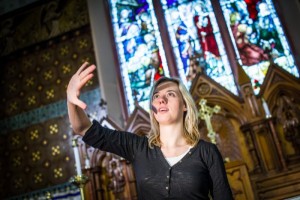Little Fire hands the questions back to the audience

Aithne starts life as a starry-eyed child prodigy, who creates beautiful, inspired paintings that she believes are sent to her by God. As she grows into adolescence, a terrible tragedy causes the visions to disappear. Without the comfort of God’s voice to lead her, Aithne must pave her own path. Caught in the crossfire of existentialism and mystical realism, and at the mercy of an over-bearing father who wants to nafunetize her gift, Aithne struggles to find meaning in her life. As her own life begins to unravel, Aithne crosses paths with others for whom circumstances have conspired and left them deflated.
Above all, I was struck by the lack of fortune that permeates these characters’ stories. Each one has met a challenge that has become their undoing. Playwright Megan Piercey Monafu has created a stage-world where God has left the building–and so now what are they to do? Piercey Monafu’s script contains some moments of beauty through sweeping, poetic monologues that evoke colourful imagery. And in actress Emily Bozik’s hands, these monologues are given a powerful presence on stage.
Bozik finds a strong stage partner in Johnny Wideman, who plays Roy. Roy is set adrift by his inability to find meaning in his work, when a set of circumstances lands him in jail. Wideman’s portrayal of Roy perfectly contrasts Bozik’s portrayal of Aithne. Where Aithne is thoughtful, Roy is perturbed, and where Aithne is profound, Roy is crude. Wideman turns Roy into a comical counterpart for Aithne, and it works. William Beddoe takes on the role of Aithne’s father, and he is subtly loathsome in a way that suits the character very well. Carol Sinclair plays a homeless woman and others, but paces and casts her eyes about wildly regardless of the character. It’s somewhat distracting.
The story behind the script is drawn from (or must be drawn from!) Akiane Kramarik’s real-life story of divine inspiration, which made its way through the major news outlets a few years ago. Born to atheist parents, Akiane was famed for her paintings of Jesus which she claimed were given to her by God. The smiling, blond, bright-eyed girl is perfectly captured in Manafu’s casting of Bozik. But where Akiane’s story hovers in a perfect moment, here we get to watch Aithne’s version of that story fall apart.
The set (Andrew Classen) was quite simple, which allowed the characters to move in and out of the various settings throughout the play convincingly. A pew sat in the middle of the stage, and a small table with candles stood at the back left-hand side. Empty canvases lean against the table; a representation of Aithne’s inspired work. An important locale in the play–adjacent prison cells where Aithne and Roy find themselves–is depicted through clever lighting (Fraser MacKinnon) that helps to sell the illusion.
The play broadly explores these characters’ perspectives on religion, faith, and being. Yet, it seems to arrive at very little. This isn’t a good or a bad thing, it just is. While the play sets up dialogues that embody the chasms between spirituality and cynicism, naivety and knowing and right and wrong, the play doesn’t come across as pedantic or enlightened. Instead, it hands the questions back to its audience to do with what they will.